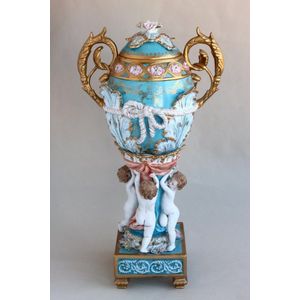Royal Worcester Hand-Painted Orchid Vase with Lid
You must be a subscriber, and be logged in to view price and dealer details.
Subscribe Now to view actual auction price for this item
When you subscribe, you have the option of setting the currency in which to display prices to $Au, $US, $NZ or Stg.
- Socle - The short plinth, usually cylindrical, that serves as a pedestal for a sculpture or vase
- Finial - An architectural decoration, found on the upper parts of of an object. On furniture they are usually found on pediments, canopies and shelf supports. On smaller ceramic or silver items, such as spoons, they may decorate the top of the item itself, or the lid or cover where they provide a useful handle for removal.
Finials have a variety of shapes and forms. They may be urn-shaped, baluster shaped round or spiral, but usually taper into an upper point. Many real life shapes may also be used as finials, such as pineapples, berries, pinecones, buds, lotus and acorns. Sometimes animals such as a lion are depicted, or fish and dolphins. - Knop (ceramics) - In ceramics, a knop is a protuberance on the top of an object, and can be either decorative, or used as a knob to lift the item.
- Ivory - Ivory is a hard white material that comes from the tusks of elephants, mammoth, walrus and boar, or from the teeth of hippopotamus and whales. The ivory from the African elephant is the most prized source of ivory. Although the mammoth is extinct, tusks are still being unearthed in Russia and offered for sale.
Ivory has been used since the earliest times as a material for sculpture of small items, both in Europe and the east, principally China and Japan.
In Asia ivory has been carved for netsuke, seals, okimono, card cases, fan supports, animals and other figures and even as carved tusks.
In the last 200 years in Europe ivory has been used to carve figures, for elaborate tankards, snuff boxes, cane handles, embroidery and sewing accessories, in jewellery and as inlay on furniture. Its more practical uses include being used for billiard balls, buttons, and a veneers on the top of piano keys.
The use and trade of elephant ivory have become controversial because they have contributed to Due to the decline in elephant populations because of the trade in ivory, the Asian elephant was placed on Appendix One of the Convention on International Trade in Endangered Species (CITES), in 1975, and in January 1990, the African elephant was similarly listed. Under Appendix One, international trade in Asian or African elephant ivory between member countries is forbidden. Unlike trade in elephant tusks, trade in mammoth tusks is legal.
Since the invention of plastics, there have been many attempts to create an artificial ivory
This item has been included into following indexes:
- Roberts, Frank - Royal Worcester artists 103
-
Royal Worcester (England), item types
- other 3,511
- vases, with covers 359
Visually similar items

Stunning French twin handled pedestal vase and cover, of egg form, accented with raised acanthus and roped motifs to the body on a powder blue ground painted with gilt floral sprays, supported by four putto on square base, on four feet, flanked by scrolled

Antique Royal Worcester porcelain twin handled pedestal vase, the fruit decoration signed Chivers, date code for 1901

Royal Worcester cobalt blue and gold vase, central reserve hand painted with flowers. Elaborate gilding. Approx. 28 cm high

An early 19th century Spode lidded bowl decorated with three gilded griffins and handpainted flowers. Marked Spode 225.5 cm. To base. Height 18 cm. Width 16 cm
